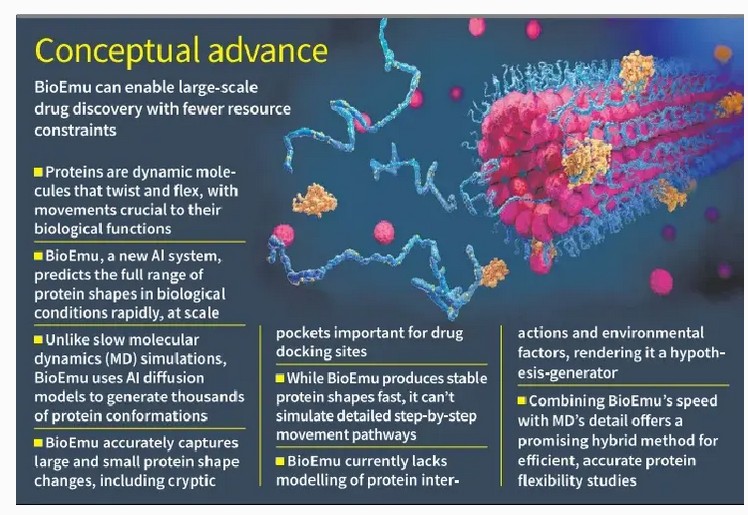Why in the News?
In a breakthrough, scientists have developed BioEmu—an AI tool that predicts the full range of protein shapes, offering faster and scalable insights into protein dynamics.

What is BioEmu?
- Overview: It is a deep learning tool that predicts the equilibrium ensemble of a protein — meaning all the different shapes a protein can naturally take.
- It works like diffusion models, starting with random/noisy inputs and learning to rebuild protein shapes.
- Training: It was trained on-
- AlphaFold structures (millions of predicted proteins)
- Molecular dynamics (MD) simulation data (200 ms)
- 500,000 mutant sequences from lab experiments
- Speed: Once trained, BioEmu can quickly create thousands of 3D protein structures on a single GPU in just minutes to hours.
Key Features of BioEmu:
- Flexibility Capture: Shows how proteins change shape, fold/unfold, or form hidden binding pockets.
- Accuracy:
- Detects 83% of large and 70–81% of small shape changes.
- Predicts open/closed forms of enzymes like adenylate kinase.
- Mutation Analysis: Helps see how mutations affect protein structure and stability.
- Fast & Scalable: Much faster than traditional MD simulations; works on thousands of proteins using less computing power.
- Snapshots Only: Gives static 3D shapes, not full motion timelines.
- Limitations: Can’t handle membrane proteins, drug molecules, or multi-chain complexes.
Why is BioEmu Important?
- Improves Protein Modelling: Adds to what AlphaFold does by showing how proteins move, not just what they look like.
- Helps Drug Discovery: Finds hidden drug binding sites — speeding up the search for new medicines.
- More Accessible: Works on basic hardware, making advanced protein modelling available to more researchers.
- Combines with Other Tools: Can be used with molecular dynamics for deeper study.
- Future of Research: Encourages students and scientists to learn a mix of AI, biology, and physics.
| [UPSC 2020] Which of the following statements are correct regarding the general difference between plant and animal cells?
1. Plant cells have cellulose cell walls whilst animal cells do not. 2. Plant cells do not have plasma membrane unlike animal cells which do. 3. Mature plant cell has one large vacuole vacuoles. Select the correct answer using the code given below: Options: (a) 1 and 2 only, (b) 2 and 3 only, (c) 1 and 3 only * (d) 1, 2 and 3 |
Get an IAS/IPS ranker as your 1: 1 personal mentor for UPSC 2024

